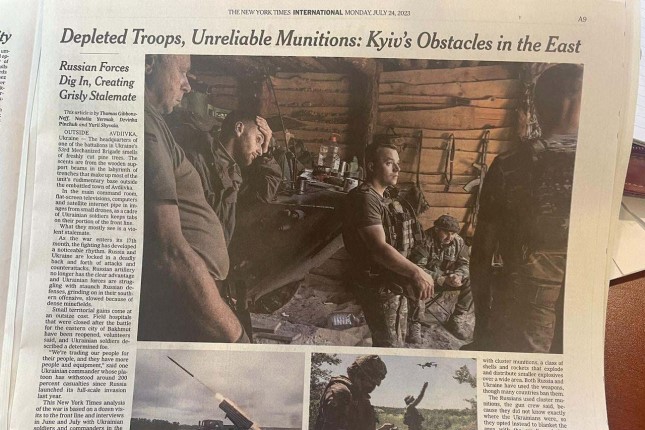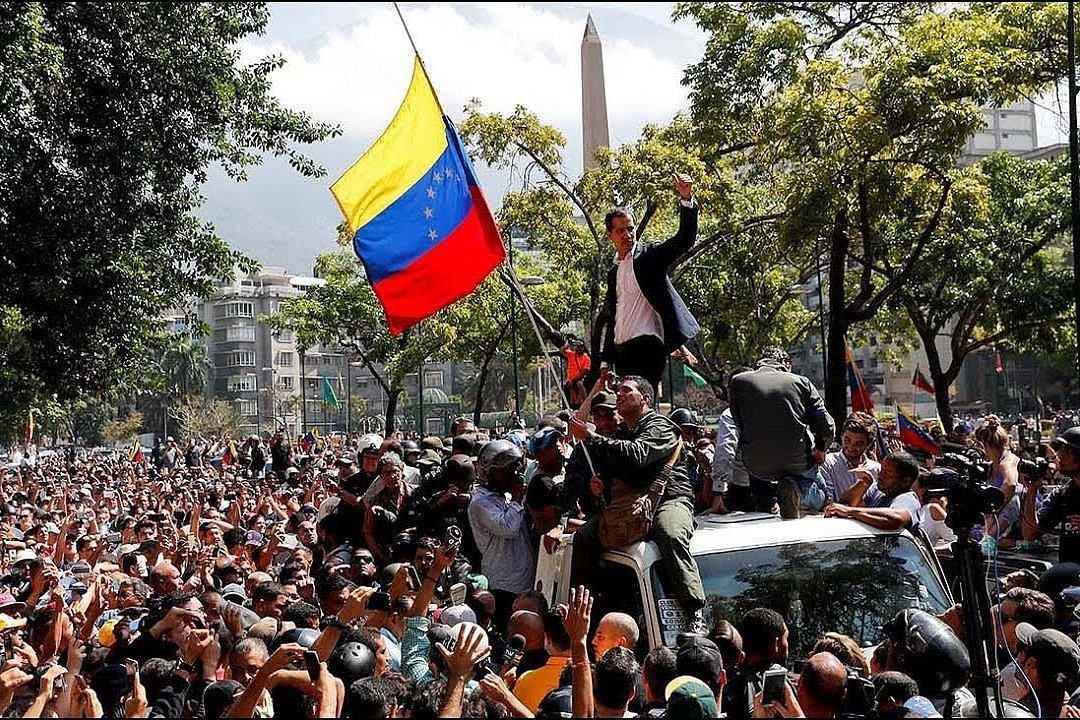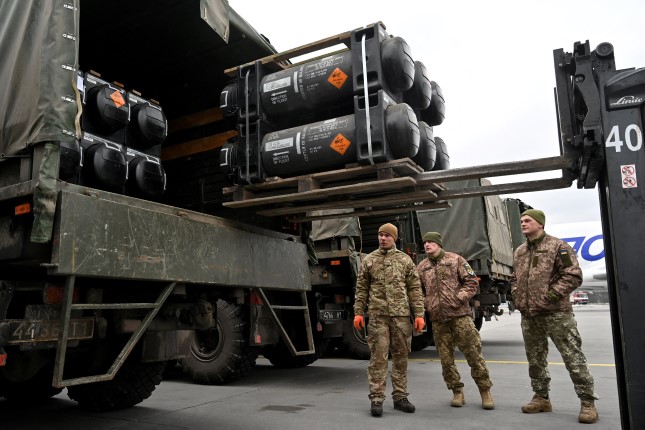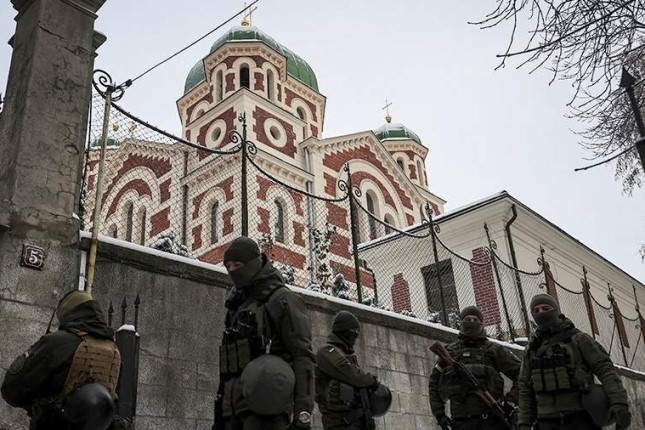But this offensive, now six weeks old, has turned into a debacle. While Ukrainian forces have nowhere breached Russia’s main defensive line, tens of thousands of troops have died.
This is the context in which the New York Times published and quickly edited an article presenting a realistic, and therefore nightmarish, depiction of the Ukrainian troops as little more than cannon fodder, “forced into action” to face almost certain death.
Buried on page A9 and not referenced on the front page of the print edition, the extensive and detailed report on Ukraine’s offensive was titled, “Depleted Troops, Unreliable Munitions: Kyiv’s Obstacles in the East.” It included a sub-headline describing the offensive as a “grisly stalemate.”
With equally little notice, that article had been published online the day before under the title, “Weary Soldiers, Unreliable Munitions: Ukraine’s Many Challenges.”
The article presented Ukraine’s offensive as a bloody debacle, in which Ukrainian forces have suffered massive casualties, who are then replaced with older recruits who are “forced” to fight.
The article documented three new, previously undisclosed revelations:
- There exists a unit in Ukraine with a “200 percent” casualty rate, meaning that all of its members were killed or injured, then replaced with recruits, all of whom were killed or injured.
- The munitions provided to Ukraine are often so old that they regularly misfire or accidentally detonate, injuring soldiers.
- After young troops are killed in combat, they are typically replaced with much older people, a sign that Ukraine is running out of fighting-age troops.
Typically, a journalist who uncovered these facts based on firsthand reporting would proclaim each of them a “scoop” and take to Twitter to publicize them.
But the method of the New York Times is that of the “buried lede”--to take these potentially explosive revelations and stick them in an article on the inside pages, which is quickly removed from the newspaper’s online front page.
In this case, however, merely burying these revelations was insufficient. It was necessary to erase them.
The first snapshot of the article was captured by archive.org at 5:32 a.m. Eastern Time. Over the ensuing 24 hours, a series of major changes was implemented, with no public notice, in which all three of the facts presented above were effaced.
The initial version of the article published online contained a paragraph stating that Ukraine was achieving “small territorial gains” at an “outsize cost.” It continued with the following quote: “We’re trading our people for their people and they have more people and equipment,” said one Ukrainian commander whose platoon has suffered around 200 percent casualties since Russia launched its full-scale invasion last year.
This paragraph was revised as follows: “We’re trading our people for their people, and they have more people and equipment,” said one Ukrainian commander whose platoon has suffered around [sic] heavy casualties since Russia launched its full-scale invasion last year.
In this case, “200 percent” was replaced with “heavy,” (albeit in such a hasty manner that the preceding word, “around,” remained). In the Battle of Normandy, in which 156,000 Allied soldiers landed on the beaches, approximately 10,000, or 6 percent, were killed or injured in what would typically be described as “heavy” casualties.
An excerpt of the Times article, showing additions in green and deletions in red. The modified language currently reads "around heavy."
By contrast, the original language in the Times article implied that the entire unit was killed or wounded, then replaced, and the entire replacement unit was killed or wounded again.
This is a jaw-dropping figure, perhaps totally unheard of since the First World War, if even then. Rather than explaining it, the Times simply expunged it from the record, never to be seen again by readers of the Times.
The modifications continued. The next (literally) explosive revelation in the article was the statement that the munitions being sent to Ukraine, often to clear out expiring stockrooms for the imperialist powers, would regularly explode as Ukrainian troops were handling them. The article originally read as follows: Ammunition, as always, is in short supply, and there is a mixture of munitions sent from different countries. That has forced Ukrainian artillery units to use more ammunition to hit their targets, since accuracy varies widely between the various shells, Ukrainian soldiers said. In addition, some of the older shells and rockets sent from abroad are damaging their equipment, and injuring soldiers. “It’s a huge problem,” said Alex, a Ukrainian battalion commander.
The last sentence was modified to read as follows: In addition, some of the older shells and rockets sent from abroad are damaging their equipment and injuring soldiers. “It’s a very big problem now,” said Alex, a Ukrainian battalion commander.
An excerpt of the Times article, showing additions in green and deletions in red.
Modern artillery munitions typically have a shelf life of 10 to 15 years. After that time, it becomes hazardous to operate these munitions, which are prone to misfires and accidental detonations.
The rate at which “older” and possibly expired munitions misfire and accidentally detonate is, apparently, a “huge” problem for Ukrainian troops. At least it was, until the problem was downgraded to “very big” by the Times editors, again without explanation.
The article continued: But other Ukrainian formations elsewhere on the front have had trouble filling their ranks with the caliber of soldiers capable of carrying out successful trench attacks, given that months of fighting have exhausted their ranks. New replacements are often older recruits who were forced into action.
This article replaces this line with the following: But other Ukrainian formations elsewhere on the front have had trouble filling their ranks with the caliber of soldiers capable of carrying out successful trench attacks, given that months of fighting have exhausted their ranks. New replacements are sometimes older recruits who were mobilized.
An excerpt of the Times article, showing additions in green and deletions in red.
Instead of replacements for the troops that were killed being “often” older recruits, they are now “sometimes” older recruits. Moreover, instead of being “forced into action,” the troops are now “mobilized.”
The following paragraph gives context to what is being described: “How can you expect a 40-year-old to be a good infantry soldier or machine-gunner?” asked the Ukrainian commander whose platoon had taken dozens of casualties. Youth not only means better physical prowess, but younger soldiers are less likely to question orders.
In other words, it is “often” the case that the soldiers “forced into action” are close to middle-age and, moreover, “question orders” when they are told to carry out suicidal attacks.
The changes to this article are a microcosm of US media reporting on the war. The horrendous, bloody debacle of the war in Ukraine is systematically sanitized, with certain topics clearly taboo and in many cases completely expunged from the media.
To cite just one example, a search for the term “Ukraine conscription” in the publicly accessible AP news image database returns only five results, all of them dealing with conscription in Russia.
Even though Ukraine has its entire prime-age population under arms, the US media seems to have an internal code that does not allow these images of recruitment and mobilization to be transmitted to the population.
Just one month ago, Times columnist Bret Stephens mused of the offensive bringing a “crushing and unmistakable defeat” for Russia, while Washington Post columnist Max Boot quoted General David Petraeus as stating that he expected “the Ukrainians to achieve significant breakthroughs and accomplish much more than most analysts are predicting.”
It has produced something else: A nightmare on the scale of the First World War, in which whole units are wiped out, replaced with conscripts, then wiped out again, then told to assault well-defended trenches.
In September of last year, the World Socialist Web Site characterized the growing calls in the US media and political establishment for Ukrainian forces to go on the offensive against well-defended Russian trenches as follows: Human life means nothing to the Washington warmongers or their stooges in Kiev. ... The lives of Ukraine’s youth, many of them conscripted, are being squandered, mere cannon fodder, or to use the phrase favored by Leo Tolstoy, “cannon meat.”
These warnings have been horrifyingly confirmed.
Photo: Page A9 of Monday's New York Times.
Source: World Socialist Web Site.































